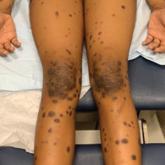Article

Enhanced Care for Pediatric Patients With Generalized Lichen Planus: Diagnosis and Treatment Tips
- Author:
- Vivian Li, DO
- Leila Parsa, DO
- Abdul Ansari, DO
- Tam Nguyen, DO
- Stanley Skopit, DO
The rarity of generalized lichen planus (LP) in children often leads to misdiagnosis or delayed treatment, impacting the patient’...
